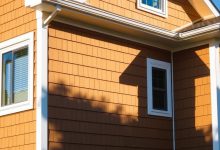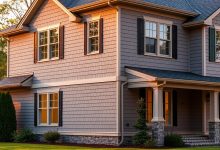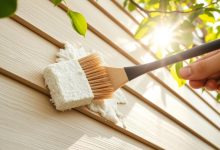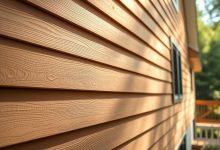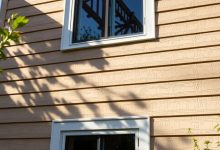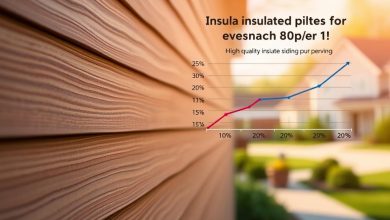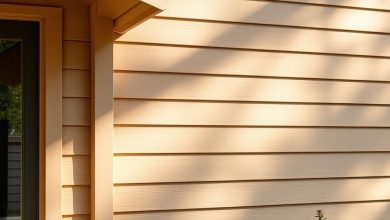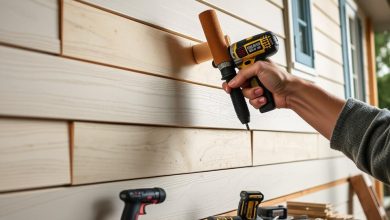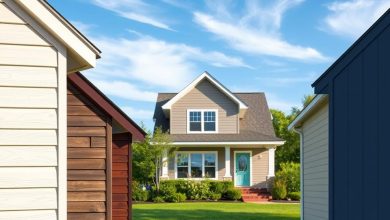Wood Insulated Siding: Durable and Energy-Efficient
Homeowners looking to improve their home’s look and save energy are choosing durable siding options. Wood insulated siding is a top pick. It mixes the beauty of wood with the latest in insulation.
This siding is not just tough on the outside. It also cuts down on heat loss, making it a smart energy-efficient siding choice. Homeowners save on bills and help the planet by using less energy.
Key Takeaways
- Wood insulated siding offers a durable and energy-efficient solution for homeowners.
- It combines the natural look of wood with advanced insulation technology.
- This siding option reduces heat loss and lowers energy consumption.
- Homeowners can benefit from reduced utility bills and a smaller carbon footprint.
- It’s an attractive choice for those seeking to enhance their home’s exterior.
What Makes Wood Insulated Siding Special
Wood insulated siding is a new and better choice compared to old siding materials. It looks great and works well, making it a top pick for homes.
The Unique Structure of Insulated Wood Siding
The unique structure of insulated wood siding has an extra insulation layer. This layer helps to reduce heat transfer. It keeps homes warm in winter and cool in summer.
How It Outperforms Traditional Siding Options
Insulated wood siding beats old siding in energy saving and lasting longer. Its insulation layer protects against weather, cutting down on extra insulation needs. This makes homes more comfortable.
Choosing insulated wood siding means a home that saves energy. This leads to lower bills for heating and cooling. It’s a smart pick among exterior siding options.
Key Benefits of Wood Insulated Siding
Wood insulated siding brings many benefits to a home. It’s a home insulation solution that combines energy efficiency, comfort, and beauty.
Enhanced Home Comfort Year-Round
Wood insulated siding keeps your home at a steady temperature. It’s warmer in winter and cooler in summer. This is thanks to its insulated core, which blocks heat transfer and cuts down on thermal bridging.
Noise Reduction Properties
It also reduces noise, making your home quieter and more peaceful. The siding’s dense material absorbs sound, cutting down on outside noise.
Aesthetic Appeal and Curb Value
Wood insulated siding looks great and boosts your home’s curb appeal. It’s made from sustainable siding materials like wood, adding a unique touch that fits many styles.
Natural Beauty and Character
The natural look of wood siding adds warmth and charm to your home’s exterior. It makes your home more inviting and can raise its market value.
Customization Options
You can pick from different wood types and finishes to make your siding unique. This lets you personalize your home’s look to match its design.
Choosing wood insulated siding means a more comfortable, quieter, and beautiful home. It’s a smart choice for any homeowner.
Popular Wood Species for Insulated Siding
Many wood species are used for insulated siding, each with its own benefits. The right choice depends on looks, durability, and if it’s good for the environment.
Some woods are more popular because they resist decay and insects well. They are also easy to find and affordable.
Cedar: The Premium Choice
Cedar is a top pick for insulated siding. It naturally resists insects and decay. Its smell also keeps pests away, cutting down on chemical use.
Redwood: Naturally Resistant
Redwood is a favorite for its natural beauty and strength. It stands up well to weather and doesn’t decay easily. This makes it great for siding.
Pine and Spruce: Budget-Friendly Options
Pine and spruce are good choices if you’re on a budget. They’re eco-friendly and can be made stronger with treatments.
Engineered Wood Products
Engineered wood uses wood fibers or strands glued together. It’s a green option that uses wood waste. It comes in many forms, perfect for siding.
Using these wood species for siding has many benefits:
- They last longer and resist the weather better
- They save energy because of the insulation
- They look good and can raise your home’s value
- They’re eco-friendly because they come from renewable sources
Understanding Wood Insulated Siding Systems
Wood insulated siding is a complex system for homeowners to understand. It involves advanced technologies that boost its performance. Knowing how it works is key to making smart choices for your home’s exterior.
Foam Board Backing Technology
The foam board backing is a critical part of wood insulated siding. It’s a rigid foam attached to the back of the wood siding. This greatly improves its ability to keep your home warm or cool.
The foam acts as a shield, stopping heat from moving between inside and outside. This makes your home more comfortable year-round.
Rigid Foam Integration Methods
There are different ways to add rigid foam to wood insulated siding. Some makers attach the foam in the factory. Others do it when they install the siding.
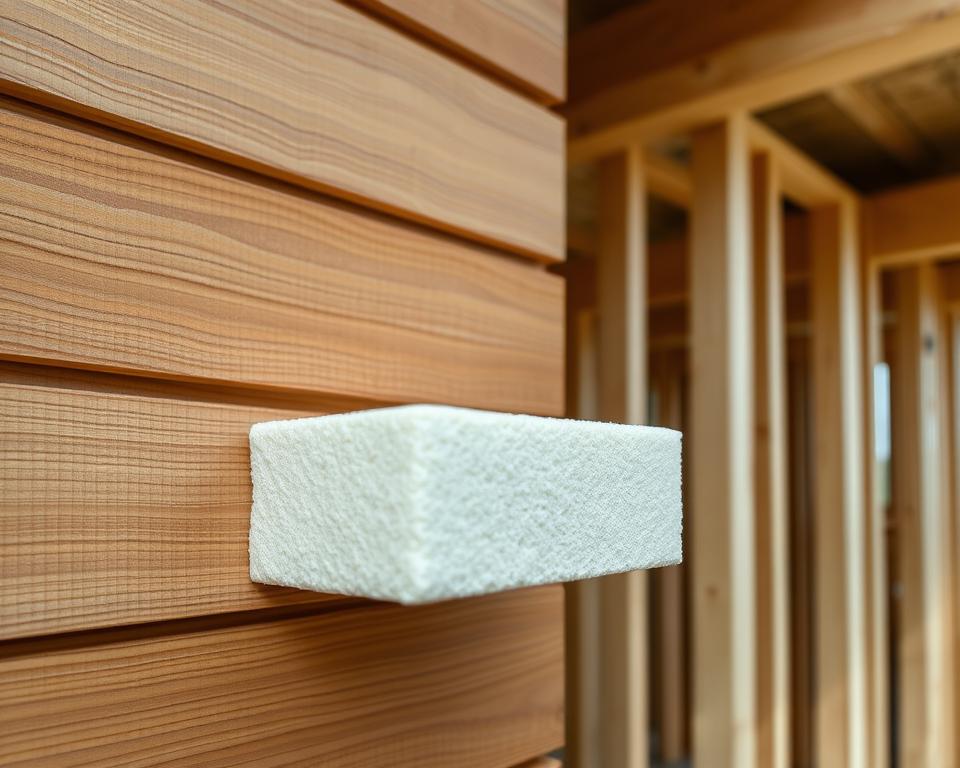
Eco-Friendly Insulation Alternatives
The push for green living has led to new insulation options. These include materials from recycled content and those sourced sustainably.
Recycled Content Options
Now, some siding products use recycled materials in their insulation. This cuts down on waste and offers a greener choice for homeowners.
Sustainable Manufacturing Processes
Companies are also using greener ways to make siding. They aim to lower energy use and emissions. This helps protect the environment.
| Feature | Traditional Siding | Wood Insulated Siding |
|---|---|---|
| Insulation | Limited or separate installation | Integrated foam board backing |
| Eco-Friendliness | Varies by material | Options for recycled content and sustainable manufacturing |
| Energy Efficiency | Often requires additional measures | Enhanced through rigid foam integration |
Energy Efficiency of Wood Insulated Siding
Homeowners looking to reduce their environmental impact will find wood insulated siding helpful. It not only makes homes look better but also cuts down on energy use.
R-Value Explained for Homeowners
The R-value shows how well a material keeps heat out. For wood insulated siding, a higher R-value means better insulation. Wood insulated siding usually has an R-value between R-3 and R-5.
This range helps keep homes warm in winter and cool in summer. It’s a big plus for energy savings.
Thermal Bridging Prevention
Wood insulated siding is great at stopping thermal bridging. Thermal bridging happens when heat escapes or enters through the siding, often through the framing. By adding insulation to the siding, it blocks these heat paths.
Seasonal Energy Performance
Wood insulated siding is energy-efficient all year round. It offers benefits in both winter and summer.
Winter Heat Retention
In winter, it keeps the heat in. Its insulation stops heat from escaping, making the home warmer and cozier.
Summer Cooling Benefits
In summer, it keeps the home cool. By blocking heat from entering, it reduces the need for air conditioning. This saves on energy costs.
Experts say insulated siding can save a lot of energy. It makes homes more energy-efficient. This makes it a smart choice for homeowners wanting to save on energy.
Cost Considerations for Your Home
Installing wood insulated siding is a big investment. It’s important to think about the costs and benefits. Homeowners need to consider both the upfront costs and the long-term effects.
Initial Investment Analysis
The cost of wood insulated siding is higher than some other options. But, it also comes with insulation benefits. This can save money over time. The initial investment includes the cost of materials and siding installation.
The price can change based on the job’s complexity and the contractor’s rates.
Long-Term Energy Savings Calculation
Wood insulated siding helps save energy. It keeps your home’s temperature steady, reducing heating and cooling needs. This leads to long-term energy savings.
These savings can make up for the initial cost over time.
Maintenance Costs Over Time
Wood insulated siding is durable but needs some care. The maintenance costs include inspections, cleaning, and sometimes re-sealing or painting. But, these costs are lower than many other siding types.
This makes it a good choice for saving money in the long run.
Potential Tax Credits and Incentives
Installing energy-efficient siding like wood insulated siding might get you tax credits or incentives. These can lower the project’s cost. Homeowners should check with local authorities or contractors to see what’s available.
Professional Installation of Wood Insulated Siding
The success of wood insulated siding depends a lot on installation by qualified professionals. When installed right, it works well, saving energy, lasting long, and looking great.
Finding Qualified Contractors
Homeowners need to find contractors with siding installation experience, focusing on wood insulated siding. It’s important to check references, read reviews, and make sure they’re licensed.
The Installation Process Explained
Installing wood insulated siding involves a few main steps. First, the exterior surface is prepared. Then, the siding is measured, cut, and attached to the wall. Proper ventilation is key to avoid moisture problems.
Common Installation Challenges
Installers face issues like working around windows and doors, ensuring everything is aligned right, and handling weather surprises. Overcoming these challenges is essential for a good job.
Working Around Windows and Doors
It’s important to measure and cut the siding carefully around windows and doors. This ensures the siding looks good and works well.
Proper Ventilation Considerations
Good ventilation behind the siding is vital to stop moisture buildup. This prevents mold and damage. It also keeps the siding in good shape.
Understanding the need for professional installation and the challenges it brings helps homeowners see the value of hiring skilled contractors for their exterior siding options.
Maintaining Your Wood Insulated Siding Investment
To keep your wood insulated siding looking great, regular care is key. Keeping it in good shape helps it last longer and stay energy-efficient.
Seasonal Maintenance Schedule
Having a seasonal maintenance plan is smart. In spring and fall, check your siding for damage from the weather. Look for loose or missing pieces and fix them right away.
Cleaning Techniques That Preserve Finish
Cleaning your siding right is important to keep its finish looking good. Use a mild soap and a soft brush to clean it. Don’t use high-pressure washes, as they can harm the siding.
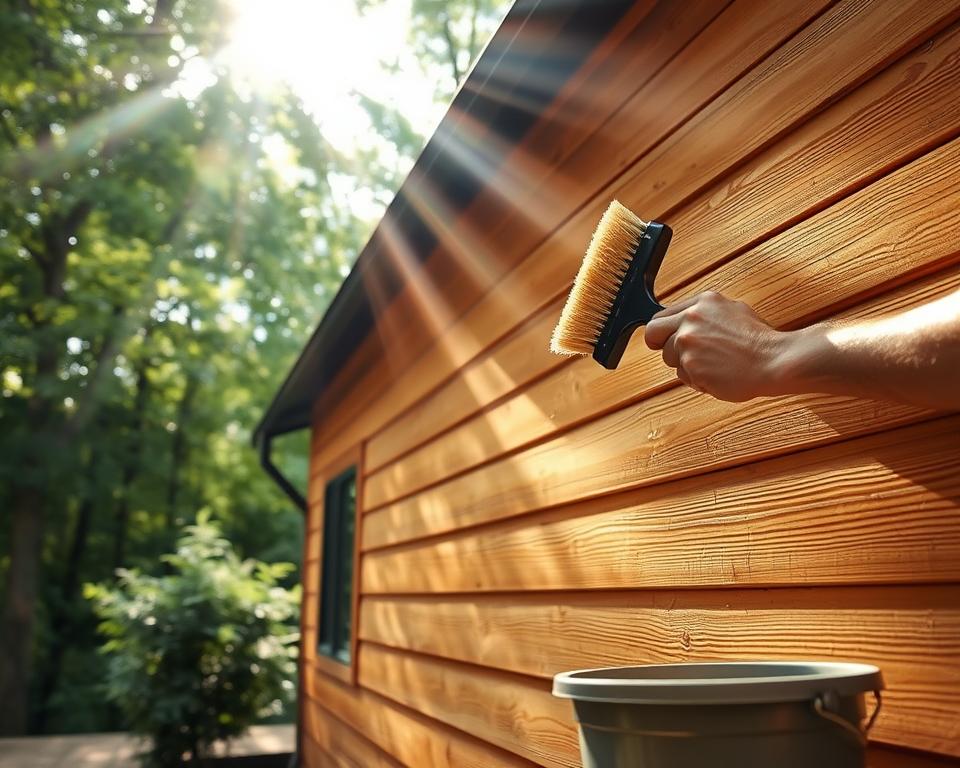
Staining and Sealing Best Practices
Staining and sealing your siding can make it last longer and look better. Choose a good stain or sealant and follow the instructions for applying it.
Addressing Damage and Repairs
Fixing damage quickly is important to avoid bigger problems. Check your siding often and fix any issues you find. For big damage, it’s best to get a professional.
| Maintenance Task | Frequency | Importance |
|---|---|---|
| Inspect siding for damage | Spring and Fall | High |
| Clean siding | As needed | Medium |
| Stain or seal siding | Every 5-7 years | High |
Weather Resistance and Durability Factors
Wood insulated siding is tough and reliable against the weather. It’s a favorite among homeowners who want eco-friendly siding.
Performance in Extreme Temperatures
Wood insulated siding works well in both hot and cold weather. It keeps your home’s temperature steady, saving on heating and cooling costs. This is great for places with big temperature changes.
Moisture Management Systems
Keeping moisture away is key for siding to last. Wood insulated siding has special systems to manage moisture. This stops water damage and reduces mold and mildew risks.
Impact and Damage Resistance
Wood insulated siding is built to withstand impacts. It’s perfect for areas with harsh weather or where branches or debris might hit your home.
UV Protection Features
UV radiation can fade and damage siding. Wood insulated siding often has UV protection. This keeps it looking good and lasting longer.
| Feature | Benefit | Weather Resistance Impact |
|---|---|---|
| Extreme Temperature Resistance | Maintains indoor temperature stability | High |
| Moisture Management | Prevents water damage and mold | High |
| Impact Resistance | Protects against physical damage | Medium |
| UV Protection | Preserves appearance and integrity | High |
Wood insulated siding is a top choice for durable, eco-friendly, and weather-resistant siding. Its many benefits make it a great option for improving your home’s look and protecting it from the elements.
Environmental Benefits of Wood Insulated Siding
Homeowners are choosing eco-friendly options more and more. Wood insulated siding is a top pick. It looks great and helps the environment.
Renewable Resource Advantages
Renewable Resource Advantages
Wood is a renewable resource. It’s good for the planet because it can grow back. This makes wood siding a green choice.
Carbon Sequestration Properties
Wood absorbs carbon dioxide. This makes it a carbon sink. It helps lower a home’s carbon footprint.
End-of-Life Recycling Options
Wood siding can be recycled or reused. This cuts down on waste. It’s better than materials that end up in landfills.
Reduced Home Energy Consumption
Wood siding insulates well. This means homes use less energy. Lower energy use means lower bills and less environmental harm.
“Using wood insulated siding is a step towards a more sustainable future for homeowners.”
Comparing Wood Insulated Siding to Alternative Materials
Homeowners looking for energy-efficient siding often explore different materials. Each has its own benefits and drawbacks. It’s important to compare these to find the best option for your home.
Vinyl Siding: Pros and Cons
Vinyl siding is affordable and easy to maintain. But, it might not be as energy-efficient as wood insulated siding. It can also get damaged by harsh weather.
Fiber Cement: Durability Comparison
Fiber cement siding is durable and resistant to pests and fire. It looks like wood but isn’t as energy-efficient. Both wood and fiber cement can last decades with the right care.
Metal Siding: Energy Efficiency Differences
Metal siding is durable and can be made from recycled materials. Its energy efficiency depends on the type and how it’s installed. Unlike wood, metal can lose heat if not well-insulated.
Brick and Stone: Aesthetic Considerations
Brick and stone siding are beautiful and long-lasting. They don’t always save more energy than wood. Your choice often depends on looks and budget.
Here’s a quick comparison:
| Siding Material | Energy Efficiency | Durability | Aesthetic Appeal |
|---|---|---|---|
| Wood Insulated Siding | High | High | Natural Look |
| Vinyl Siding | Low | Medium | Varied |
| Fiber Cement Siding | Medium | High | Mimics Wood |
| Metal Siding | Varies | High | Modern Look |
| Brick and Stone | Medium | High | High-End Look |
Conclusion
Wood insulated siding is a great choice for homeowners. It boosts energy efficiency, durability, and looks. Knowing its benefits helps homeowners pick the best insulation for their homes.
When picking siding, think about energy savings, lasting quality, and the planet. Wood insulated siding is top-notch in these areas. It’s a green and affordable choice that saves money on energy bills over time.
Choosing wood insulated siding means a cozier home, less energy use, and maybe a higher home value. As more people want green and energy-saving homes, wood insulated siding is a leading option. It’s perfect for upgrading your home’s outside look.

